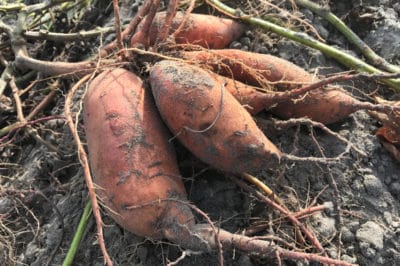Sweet Potatoes – Not Yams
Although both are perennial vines and sweet potatoes are sometimes called yams, they are very different plants and belong to different families. When a gardener talks about sweet potatoes, he or she means the colorful, slightly sweet tubers from Ipomea batata – a relative of the morning glory. True yams are white or cream-colored inside and starchy.
Growing Sweet Potatoes
If you live in USDA Zones 8 or 9, you’ll have no trouble growing sweet potatoes. In colder areas, you can start them in a greenhouse and harvest a little earlier. The tubers won’t be quite as big, but you can have a respectable crop. In either case, plant them in loose, sandy soil with reasonable fertility. Make sure they are well-watered during the growing period.
Sweet Potato Maturity
There are dozens of sweet potato varieties that are commercially available. You might also be able to get slips from an older gardener who has his or her own strain. They come in various colors, including purple, as well as the classic red-orange. Maturity dates vary. Short-season sweet potatoes – better for colder climates – are ready in about 90 days from planting the slips. Long season varieties may not mature for 140 days or more.
Possible Variety Choices
All of the sweet potatoes listed below should be readily available from nurseries and mail-order houses:
- All Purple – 120 days
- Beauregard – 90 to 100 days
- Carolina Ruby – 100 days
- Copper Jewel – 110 to 120 days
- Georgia Jet – 100 days
- Ginseng – 120 days
- Golden Kumara – 120 days or more
- Hernandez – 120 days
- O’Henry – 100 days
- Vardaman – 95 days.
Signs Your Sweet Potatoes are Ready
The published maturity date for a sweet potato variety is no more than a guide. Your climate and weather can make a difference, as can your growing techniques. Sweet potatoes may take longer to produce in drought conditions. Try a few when they “should” be ready. Keep an eye on the vines – when the tops begin to turn yellow, it usually means the tubers are ready.
Choosing Harvesting Tools
Unless your soil is heavy clay, the best tool to do the actual harvest is a potato fork. A three- or four-tined fork allows you to lever up the plants and tubers with minimal potential for damage. However, it helps to first dig a trench about 18 inches from the plant center with a pointed-end shovel. This makes it easier to get the potato fork under the tubers at the right angle.
Be Gentle
Sweet potatoes are more fragile than you might think. When first harvested, the skins are fairly thin and the flesh will bruise easily. Even after curing, if you drop a tuber or dump them out of a container into the storage area, you may have damage. Bruised spots will begin to decay and rot, spoiling the entire tuber. Always handle your sweet potatoes carefully.
Curing – An Important Step
When you first harvest them sweet potatoes are not really sweet and the texture is not ideal. You should cure your sweet potatoes before storage. Brush off loose dirt and leave them in the sun for a few hours, then move to a table or shed that is warm and has good air circulation. Let them cure for a week or 10 days to help heal small nicks and toughen the skin.
Harvest Time Matters
The longer you can leave your sweet potatoes in the ground, the larger they will be. However, they are very sensitive to cold. Frost will kill plants and rot tubers, but even cold soil without frost can cause damage. Make sure you have the crop out of the ground at least two weeks before your first expected frost – remember you must allow time for curing as well.
Harvesting Leaves
Sweet potatoes don’t just produce tubers – they also have edible leaves. You can harvest leaves at any time up until the plants start to yellow. Just pick a handful from each plant. The leaves are used like other edible greens such as kale and spinach. Cook them in boiling water and saute with oil and spices, use them in casseroles or cover with a creamy sauce.
Storage
Once they’re harvested, make sure you store them properly. A root cellar or cool basement make good storage areas. You can also can them – use a tested recipe. Cooked sweet potatoes also freeze well. Use lemon juice to prevent darkening. Like other starchy vegetables, sweet potatoes can also be sliced thin and dehydrated for storage.
